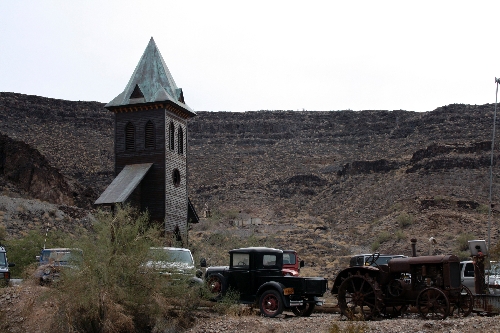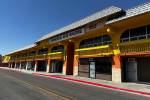Visit to saloon caps Parker Dam trip

Whether you are interested in boating, fishing, hiking, camping or just an excursion along some remote gravel back roads, Parker, Ariz., can meet your outdoor needs.
There, along the lower Colorado River, barely 100 miles from Las Vegas, you will have plenty of activities to fill a day or several. And because the elevation here is only 400 to 450 feet above sea level, it’s warmer than Las Vegas so you can enjoy most of them all winter.
A good way to start your visit is by seeing the Parker Dam, built between 1934 and 1938. No guided tours are offered here, but you don’t need a guide to get a close look. You can drive over the dam if you choose, or just take a quick peek from an overlook. You can even drive down to water’s edge on its north side.
Parker Dam doesn’t tower overhead as impressively as the Hoover or Glen Canyon dams farther up the Colorado, but it is the deepest in the world. Keep in mind that you’re seeing only about one-quarter of its 320-foot height. The dam is what formed Lake Havasu, about 45 miles long and able to store 200 billion gallons of water. While created to store water, control flooding and produce electrical power, Lake Havasu also produced a bonanza of opportunities for recreational boaters, fishermen and other outdoor folk.
Driving south from the dam along the 18-mile Parker Strip you will find plenty of places to access the river, including the 1,677-acre Buckskin Mountain State Park, where you will find a beach, a picnic area, a camping area, a boat launching area and hiking trails.
The community of Parker proper is about only 1 square mile within the 260,000 acres of the Colorado River Reservation. The reservation was established by Congress in 1865 for the "Indians of said river and its tributaries." Originally, it was intended primarily as a home for the Mohave Indians. Now, Chemeheuvi, Hopi and Navajo also share the land. Functioning politically as a single unit, the Colorado River Indian Tribes operate the Bluewater Resort and Casino a little east of the town and a heritage museum in town at 1007 Arizona Ave.
If you visit Parker on a weekend, one of the visit’s highlights should be heading some five miles into the Buckskin Mountains via a gravel but well-maintained road to visit the Nellie E. Saloon. Also known as the Desert Bar, this remote restaurant and watering hole will probably be one of the most unusual you’ll ever visit. And despite the availability of alcohol, I would not hesitate to bring children here.
It is quite worth seeing the place even if you aren’t eating. You will find antique cars and trucks scattered around the property and even a funky, solid steel, open-air church in the middle of the parking area. This is more of a façade than a true building, and no services are held in it but it makes an excellent photo op.
Entrance to the restaurant and bar is via a covered bridge. The bar is small, with just a few tables, but outside you will find the main dining area and grill, with small seating areas tucked throughout the property. A simple menu of burgers, hot dogs and other basic fare is all you will find here, but the prices are modest. Bring cash, though, for the establishment takes no credit cards.
Come early, as the place fills quickly with locals and increasing numbers of travelers. The business is open from noon to 6 p.m., Arizona time, Saturday and Sunday from October through April. Live bands play from 1 to 5 p.m., making it an even more upbeat place to be.
On the way back home, traveling north on U.S. Highway 95, outdoor lovers will appreciate stopping at the 6,105-acre Bill Williams River National Wildlife Refuge. Established in 1941, the refuge was named for a mountain man, trapper and guide active during the 1830s and 1840s.
One of the best places in the park to visit is a gravel road on the south side of the road (when heading north), just after the park’s headquarters. Here you will find a lovely riparian area of cottonwoods and willow surrounded by cliffs and hills dotted with saguaro and other Sonoran vegetation. Lots of wildlife makes a home in the refuge, including desert bighorn sheep, gray foxes and javelinas.
More than 300 bird species have been recorded here, including the brightly colored Lazuli bunting, the yellow-billed cuckoo, vermillion flycatchers and the endangered Southwestern willow flycatcher. Another endangered bird, the Yuma clapper rail, loves the marsh areas hereabouts and sometimes even winters here. And many a city-weary human will realize upon reflection that the clapper rail has a pretty good idea.
Deborah Wall is the author of "Great Hikes, A Cerca Country Guide" and "Base Camp Las Vegas: Hiking the Southwestern States," published by Stephens Press. She can be reached at deborabus@aol.com.
DIRECTIONS— Getting to Parker: From Las Vegas, take U.S. Highway 95 south through Searchlight to California, about 103 miles. Exit onto Interstate 40 going east, crossing the Colorado River into Arizona. Drive about 32 miles. Take Arizona 95 south for about 45 miles to the Parker area.
— Getting to Nellie E. Saloon: From Parker, take U.S. 95 north about five miles and then go right onto Cienega Springs Road. Follow the gravel road for five miles to the parking area and saloon. The parking area is suitable for most vehicles except during or after rain.
For more information, visit thedesertbar.com.


















